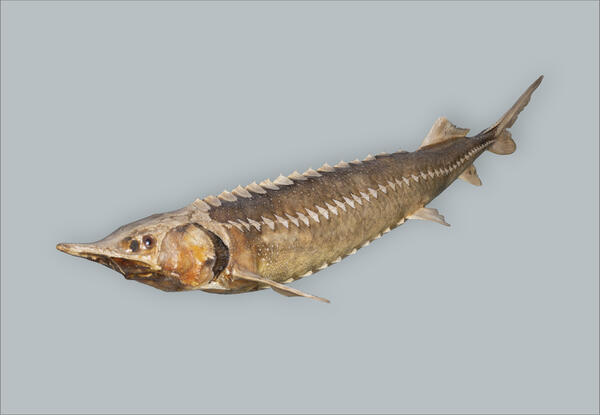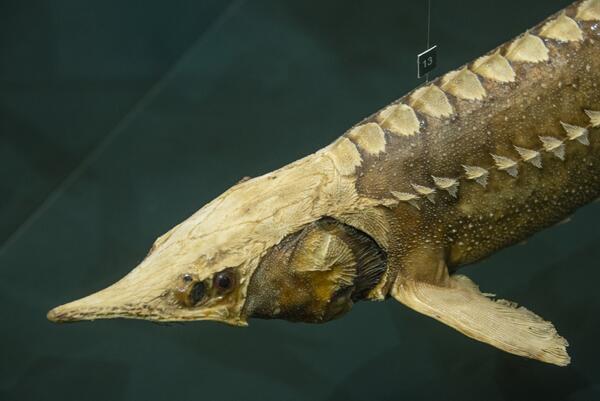The Siberian sturgeon is a valuable commercial fish. It has been harvested in the Yenisey River since the 18th century, but it was not until the 20th century that the fishery became organized.
Since the 1930s an intensive and highly irrational exploitation of fish stocks began, during which juvenile fish were caught on a massive scale. This approach has led to serious damage to the sturgeon population and to the need for drastic conservation measures. Today, the sturgeon is listed in the Red Data Book of the Russian Federation, Krasnoyarsk Territory, and the Republic of Khakassia; its commercial fishing is prohibited everywhere during all seasons.
The Siberian sturgeon can be found in Siberian rivers, the Yenisey and Khatanga Bays, and, in smaller numbers, in the Pyasin River and Lakes Lama and Melkoye. The most numerous sturgeon shoal is found in the lower reaches of the Yenisey River. There are three subspecies of this fish: the West Siberian, the East Siberian and the Baikal sturgeon. They are divided into semi-anadromous and resident, or freshwater. In the Khatanga River basin, sharp-nosed and blunt-nosed forms are found.
In June-July spawning starts on pebbly bottoms in the Yenisey; the best spawning grounds are located near Yartsevo-Vorogovo, 1500 km from the mouth. With a maximum life span of 60 years, Siberian male sturgeons of the Ob reach sexual maturity generally by the age of 9–14, and females by the age of 11–20; on the Yenisey this maturity occurs by 15 and 18, correspondingly. The sturgeon spawns throughout its life, but the frequency of spawning is not the same in different locations. Yenisey sturgeons spawn once every four years. The sturgeons from the lower reaches feed on insect larvae (chironomids and rhyacophilidae), amphipod crustaceans, small fish, and mollusks. They are almost the only fish that also isopods and annaelidae — polychaetae and oligochaetae. Adults tend to fatten up in summer at a depth of 8–10 m, while juveniles do it in fleet waters. In November and December, the sturgeons go into the holes for hibernation. However, adult fish leave for wintering earlier: their accumulated fat reserves allow them to prolong their passive resting period.
Since the 1930s an intensive and highly irrational exploitation of fish stocks began, during which juvenile fish were caught on a massive scale. This approach has led to serious damage to the sturgeon population and to the need for drastic conservation measures. Today, the sturgeon is listed in the Red Data Book of the Russian Federation, Krasnoyarsk Territory, and the Republic of Khakassia; its commercial fishing is prohibited everywhere during all seasons.
The Siberian sturgeon can be found in Siberian rivers, the Yenisey and Khatanga Bays, and, in smaller numbers, in the Pyasin River and Lakes Lama and Melkoye. The most numerous sturgeon shoal is found in the lower reaches of the Yenisey River. There are three subspecies of this fish: the West Siberian, the East Siberian and the Baikal sturgeon. They are divided into semi-anadromous and resident, or freshwater. In the Khatanga River basin, sharp-nosed and blunt-nosed forms are found.
In June-July spawning starts on pebbly bottoms in the Yenisey; the best spawning grounds are located near Yartsevo-Vorogovo, 1500 km from the mouth. With a maximum life span of 60 years, Siberian male sturgeons of the Ob reach sexual maturity generally by the age of 9–14, and females by the age of 11–20; on the Yenisey this maturity occurs by 15 and 18, correspondingly. The sturgeon spawns throughout its life, but the frequency of spawning is not the same in different locations. Yenisey sturgeons spawn once every four years. The sturgeons from the lower reaches feed on insect larvae (chironomids and rhyacophilidae), amphipod crustaceans, small fish, and mollusks. They are almost the only fish that also isopods and annaelidae — polychaetae and oligochaetae. Adults tend to fatten up in summer at a depth of 8–10 m, while juveniles do it in fleet waters. In November and December, the sturgeons go into the holes for hibernation. However, adult fish leave for wintering earlier: their accumulated fat reserves allow them to prolong their passive resting period.



